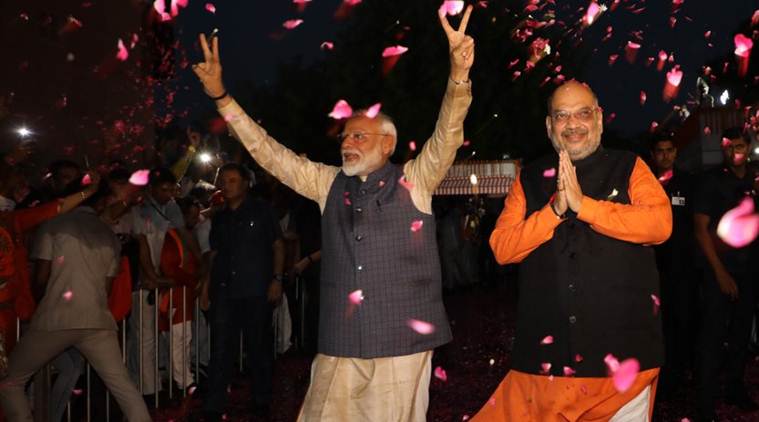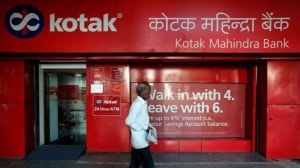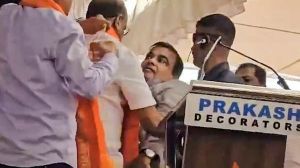- India
- International
How Narendra Modi’s mandate for 2019 is different from the one in 2014
The mandate of 2019 could not be more different: it is for religion-based muscular nationalism, or Hindutva.
 Prime Minister Narendra Modi and BJP Amit Shah at the BJP headquarters in New Delhi on Thursday. (Express photo/Tashi Tobgyal)
Prime Minister Narendra Modi and BJP Amit Shah at the BJP headquarters in New Delhi on Thursday. (Express photo/Tashi Tobgyal)
Indian voters have spoken in a clear voice: They want the government led by Prime Minister Narendra Modi to continue. At the end of five years in power, Modi’s party, the BJP, has increased its share of the vote significantly, from 31 per cent to just under 40 per cent (not final figures). That is a ringing endorsement of the party and its leader, despite the fact that his government has not delivered on matters of bread and butter: jobs and the economy. The leading opposition party, the Congress, though its vote share has declined only marginally from about 19.3 per cent to 19 per cent, has seen its vote share difference with the BJP widen dramatically from 12 to 21 per cent. The fact that the Congress lost over 90 per cent of the seats where it was in direct contest with the BJP shows the extent of its defeat.
To guess where the country would be heading from here, we need to look at the context of this year’s election as opposed to the election of 2014. Without such a comparison, it would be tempting to assume that what we are going to see is more of the same. The mandate in 2014 was widely seen as being for ‘development’, the main plank that Modi and his party campaigned on. The mandate of 2019 could not be more different: it is for religion-based muscular nationalism, or Hindutva. The victory of a terror-accused BJP candidate from Bhopal (who also called Godse, the assassin of M.K. Gandhi, “a patriot”) provides stark clarity to the electoral choices that were made by voters this time.
There is also another difference that any observer of the last two campaigns would have noticed. Those who voted Modi to power in 2014, especially those in the middle and upper classes, often went out of their way to assert that they were voting only for his party’s economic agenda, not for its social or cultural agenda. In contrast, the voters who have driven Modi to power in 2019 feel no need for such caveats. It is clear that during the intervening five years, Modi has managed not only to convert most of his ‘economics-only supporters’ to full supporters of Hindutva but also to rope in to the cause millions more who did not vote for him in 2014.
How the Prime Minister and his party have managed to do this is a multi-layered story that begins with an existing and unmet need for national assertion and goes on to involve intense and astute use of propaganda tools and welfare measures, effective control of almost all mass media and a narrative which suggested dark forces – variously called the Khan Market brigade, Lutyen’s Club or the Tukde Tukde gang – operating against national interests. And all this has to be seen in the context of the failure of the Opposition, the main Opposition party in particular, to reimagine the tattered and vague ‘Idea of India’ for the 21st century. But this is a long story that will have to be told another time.
 Narendra Modi and Amit Shah at BJP office after getting huge mandate in Lok Sabha elections 2019 on Thursday. (Source: Twitter))
Narendra Modi and Amit Shah at BJP office after getting huge mandate in Lok Sabha elections 2019 on Thursday. (Source: Twitter))
For now, it would be reasonable to assume that the mandate of 2019 will have very different meanings from that of 2014, and will likely result in the government pushing forward the agenda of Hindutva more aggressively than in its first term. V.D. Savarkar, the man who defined the term Hindutva, spelt out its mission in a succinct slogan: ‘Hinduise all politics; militarise all Hindudom’. The first part of the objective has been achieved to a significant extent. To realise this, one only has to remember that the Congress party felt it necessary to talk about the janeu or sacred thread of its leader, Rahul Gandhi, marking him out as a Brahmin. Or listen to the Prime Minister’s speech to party workers after the win: “Those who used to speak of secularism have now stopped that kind of talk. Not even one political party in this election came wearing the veil (niqab) of secularism.”

The second part of the objective is still work in progress, though one could say that the picture of the BJP leader and Union Minister Jayant Sinha garlanding members of a mob that lynched a Muslim last year and the nomination of a terror-accused as candidate from Bhopal suggest that progress on this has not been slow.
But what do you do after Hinduising all politics and militarising all Hindudom? The underlying assumption of Hindutva has been that for India to realise its full potential, it needs to rediscover its past glories, reconstitute the pristine and homogenous Aryan-Sanskrit-Vedic culture, and expel elements from the country’s mix of traditions and practices that are deemed foreign so that a national renaissance can begin. So in the full understanding of Hindutva, economic development is something that follows a cultural redefinition and rejuvenation, not something that precedes it. To expect the new government to focus more on the economy and development and less on cultural nationalism, therefore, would be asking it to invert its understanding of the development process.

The new government could, of course, try to make both go side by side, but the trouble is that the just-concluded elections may have given it no real incentives to do so. The electorate has clearly given the signal that it cares less about bread and butter issues and more about a strong, Hindutva-coloured nationalism. In fact, the victory margin of the BJP has been the highest precisely in states that have borne the maximum economic distress, such as Uttar Pradesh, Bihar, Gujarat and Maharashtra.
But is the idea that a cultural regeneration will lead to economic resurgence supported by history? Not really. It is based on a misunderstanding that European Renaissance between 1400 and 1700 AD (which saw Europeans taking a growing interest in ancient Roman and Greek ideas about art, literature and sciences) gradually led to the industrial revolution and that this process can be replicated. But it ignores the fact that this interest on the part of Europeans in ancient Roman and Greek achievements led to a replacement of their long-held religious beliefs by a more rational and scientific approach to the world around them. The Renaissance that Hindutva wants to bring about intends to do the reverse: go back to ancient periods so as to revive or rejuvenate religious beliefs, not replace them.
 Bharatiya Janata Party (BJP) supporters celebrate in their party’s Assam state office in Gauhati, India, Thursday, May 23, 2019. Indian Prime Minister Narendra Modi and his party have a commanding lead in early vote counting from the country’s six-week general election. (AP Photo/Anupam Nath)
Bharatiya Janata Party (BJP) supporters celebrate in their party’s Assam state office in Gauhati, India, Thursday, May 23, 2019. Indian Prime Minister Narendra Modi and his party have a commanding lead in early vote counting from the country’s six-week general election. (AP Photo/Anupam Nath)
The bigger issue, however, is that the idea of an ancient, pristine and homogenous culture that gave rise to everything good in this land is also based on a misunderstanding. We now know that the Indian population is mainly a mix of four major prehistoric migrations, starting with the Out of Africa migrants who reached here 65,000 years ago, thus becoming the First Indians; agriculturalists from the Zagros region of west Asia who reached here around 9000 years ago and mixed with the First Indians to spread farming in north-western India that finally led to the Harappan Civilization; Austro-Asiatic language speakers (such as Mundari and Khasi of central and eastern India) who arrived here from east Asia around 4000 years ago; and Indo-European language speakers who called themselves Arya who migrated here from the Central Asian Steppes between 4000 and 3000 years ago (see my book: ‘Early Indians: The Story of Our Ancestors and Where We Came From’). This is not to speak of many other migrations that happened in the later, historic period that did leave a cultural mark on the country, though very little genetic mark on our demography.
The genius of India is that it has created a unique, highly influential and common civilisation out of the disparate streams that flowed into it at different times in its long history. The sources of our common culture, therefore, are many, not singular. To try and retrofit India’s diversity to an imagined monochromatic uniformity would be an exercise that is out of character, prone to mishaps and doomed to failure. But for now, the electorate has spoken and it is up to the ruling party to decide what to do with the verdict. Let us hope they will stay true to the inclusive nature and ethos of our civilisation.
Tony Joseph is the author of ‘Early Indians: The Story of Our Ancestors and Where We Came From’
EXPRESS OPINION
More Explained
Apr 24: Latest News
- 01
- 02
- 03
- 04
- 05










































